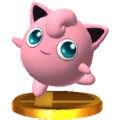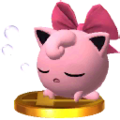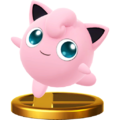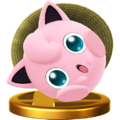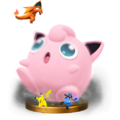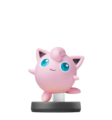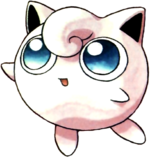| Welcome to SmashWiki! Log in or create an account and join the community, and don't forget to read this first! |
| Notices |
|---|
| The Skill parameter has been removed from Smasher infoboxes, and in its place are the new "Best historical ranking" and "Best tournament result" parameters. SmashWiki needs help adding these new parameters to Smasher infoboxes, refer to the guidelines here for what should be included in these new parameters. |
| When adding results to Smasher pages, include each tournament's entrant number in addition to the player's placement, and use the {{Trn}} template with the matching game specified. Please also fix old results on Smasher pages that do not abide to this standard. Refer to our Smasher article guidelines to see how results tables should be formatted. |
| Check out our project page for ongoing projects that SmashWiki needs help with. |
Jigglypuff (SSB4)
| Jigglypuff in Super Smash Bros. 4 | |
|---|---|
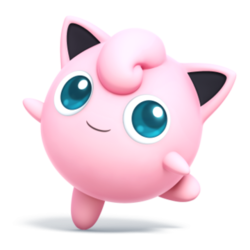 
| |
| Universe | Pokémon |
| Other playable appearances | in SSB in Melee in Brawl in Ultimate |
| Availability | Unlockable (3DS) Starter (Wii U) |
| Final Smash | Puff Up |
| Tier | G (55) |
Jigglypuff (プリン, Purin) is a playable character in Super Smash Bros. 4. After initially being seen several times during the Super Smash Bros. for Wii U 50-Fact Extravaganza on October 23rd, 2014,[1] it was formally added to the official website on November 5th, 2014.
Jigglypuff is once again voiced by Rachael Lillis in English and Mika Kanai in Japanese, albeit via recycled voice clips from Super Smash Bros. Melee and Super Smash Bros. Brawl. As in previous games, it also has different voice actresses in French and German.
Jigglypuff is ranked 55th out of 55 on the tier list, placing it at the very bottom of the entire list, in the G tier. This is a slight drop from its already very low ranking in Brawl at 36th out of 38th, and its worst placement in the series. Jigglypuff retains its strong air game due to its high aerial mobility thanks to its very fast air speed and multiple midair jumps, as well as good juggling ability thanks to its fast and long-lasting aerial attacks. All of these attributes facilitate strong edgeguarding potential, and allows it to solidly perform its signature Wall of Pain technique, while it retains potent KO options between its newly buffed neutral aerial, back aerial, and Rest.
However, Jigglypuff is strongly held back by its poor ground game, due to its poor mobility on the ground and short range on most of its attacks, including its grab. Furthermore, Jigglypuff has significant difficulty in KOing opponents, as it has few reliable KO moves, and a majority of them feature considerable amounts of lag that cause them to be unsafe in most scenarios. In addition, Jigglypuff is prone to air release combos from several characters within 10 frames that can either combo or KO. Its endurance is unarguably the worst in the game, as it is extremely floaty and possesses the lowest weight in the game, further exacerbated by the new rage mechanic and weaker shields, which is further amplified by Jigglypuff immediately getting KOed if its shield is broken.
Jigglypuff is considered non-viable for tournament play, though a number of players have made some impacts at tournaments, with players such as LeeT and MASTER PUFFY performing decently in nationals, and Captain L ranking with it as a co-main on the Panda Global Rankings v5. Despite this, Jigglypuff continues to have only a small playerbase, and it has notably failed to receive any buffs from updates in the game.
How to unlock
- Play 120 VS Matches.
- Collect 30 different pieces of equipment.
After completing one of the two methods, Jigglypuff must then be defeated on Unova Pokémon League.
Jigglypuff is a starter character in Super Smash Bros. for Wii U, and is unlockable only in the 3DS version of SSB4.
Attributes
Jigglypuff is a character of extremes, as evident with its attributes: it has the second highest traction, the second fastest air speed, the highest air acceleration, the lowest falling speed, and the lowest gravity. These attributes make Jigglypuff a very mobile character in the air and give it easily controllable ground movement. However, it has the slowest walking speed and the second slowest dashing speed, the lightest weight and the lowest jump force, as well as a fairly slow jumpsquat. As such, these attributes make Jigglypuff unable to quickly traverse the stage on foot and susceptible to early KOs. To make up for its low jumping force, however, it has five midair jumps, which further enhance its aerial evasiveness. Its very low gravity also results in it taking slightly below average hitstun.
Jigglypuff's main strength is its formidable air game. Excluding back aerial, all of its aerial attacks have lingering hitboxes and, in the case of down aerial, multiple hits. Their duration is the primary reason Jigglypuff is deceptively difficult to challenge in the air, as opponents will most likely collide within an attack's final frames. All of its aerials, aside from up aerial, also have enough range to be spaced correctly thanks to Jigglypuff's aerial mobility, allowing it to zone and approach opponents safely in the air. Each of Jigglypuff's aerials also have their own distinct strengths. Neutral aerial is its fastest aerial and one of the strongest sex kicks in the game, even when stale, and can easily gimp poor recoveries due to its late hitbox being sufficiently strong enough to do so. Due to its speed and power, it also works as a good out of shield or approach option, and its long duration allows it to break combos. Forward aerial has the second weakest knockback of Jigglypuff's aerials, but this grants it good combo potential in return. It can also easily put opponents off-stage, and is the main component of the wall of pain technique: once an opponent with a poor recovery is launched off-stage, Jigglypuff can follow up with several other forward aerials until they reach the blast zone, where Jigglypuff can finish the opponent off with another forward or a neutral aerial. Back aerial is Jigglypuff's strongest aerial, KOing reliably at 135%, and having a remarkable range, given Jigglypuff's small size. It is also safe on shield due to its high damage output and above average hitlag, though it is also its slowest aerial, making it a bit predictable. Up aerial has a deceptively long-lasting hitbox, which can be problematic for any opponent that has issues dealing with juggling, and it is also a situational finisher near the upper blast line. Lastly, down aerial can be used as a highly damaging out of shield or pressuring option, dealing up to 14% damage, and has low ending lag. It can sometimes also work as an anti-juggling option against characters with slow aerial mobility or moves.
Jigglypuff's unmatched floatiness, very fast air speed, multiple jumps and strong air game give it a tremendous off-stage presence. Due to lacking a traditional recovery move, its recovery is fairly susceptible to gimping, though its other attributes make its recovery very effective regardless. Its fast air acceleration also allows it to disorient opponents that attempt to edgeguard it. With the aid of Pound, it can also stall its recovery and protect its landing. Jigglypuff is fearsome at edgeguarding: with proper spacing and good timing, it can gimp all but the farthest distanced recoveries without being put at risk; characters such as Cloud and Ness are the most susceptible to its edgeguarding, as their recoveries lack both speed and resilience.
Finally, Jigglypuff has a trump card in Rest, its signature move; it has very high vertical knockback at all percentages, to the point where it can reliably KO any character at 70%, but KOs most characters at as early as 50%. It hits on frame 2 with a flower effect and has full intangibility until Jigglypuff closes its eyes. In addition to being a strong punishment option, the threat of Rest forces opponents to be very careful when using laggy moves, especially due to Jigglypuff's ability to perform an occasionally situational true combo into it. The easiest way to confirm a Rest is with forward aerial: hitting with the move's final frames will lead into an unavoidable Rest, which becomes even more potent if used in the air or with high rage. Depending on the opponent's falling speed, a jump may be necessary to reach them. Another reliable way to confirm one is by landing with up aerial: should Jigglypuff land immediately after hitting the opponent, Rest can be landed without fail. This combo works optimally on platforms due to its limited percentage range and its ability to KO as low as 35%.
Up tilt can also lead into Rest, which can be used to rack up at least 30%, but opponents can be launched too far away past low percentages. Lastly, retreating with down aerial can also work, but aside from being the hardest to perform, it is also the least likely to succeed. Other methods of safely using Rest involve crouching, buffering, a footstool jump, a jab reset, or interrupting an opposing neutral attack, though few characters are vulnerable to these methods, and they usually require impeccable timing. Platforms can be a saving grace when considering Rest, as they can lead into 0% KO confirms on certain characters and, if they are moving, can make it a bit harder to punish. For all its potential, however, Rest has the slowest interruptibility in the game, allowing Jigglypuff to move only after five and a half seconds if the move is inputted, making it easy to punish, even if it KOs the opponent, and thus being a gamble to attempt in almost any circumstance.
However, Jigglypuff is held back by numerous weaknesses, which are severe enough to outweigh its strengths. The most detrimental is its frailty: Jigglypuff's stats result in it having the lowest endurance in the game, potentially being knocked out as early as 35% with a sufficiently strong attack. The introduction of rage is an additional burden, since opponents can send it flying even earlier, in some instances a combo being all it takes for Jigglypuff to be KO'd even at 0%. These drawbacks force Jigglypuff to play extremely cautiously, as any damage taken can prove dangerous in the long run. Adding insult to injury, Jigglypuff's shield jump has enough force to KO it even from the very bottom of Palutena's Temple. This makes shielding very risky at low percentages, as the possibly survivable punishes normally received after a shield break are replaced by a guaranteed KO that can only be stopped by a ceiling.
Furthermore, Jigglypuff has a very problematic ground game. While most of its ground moves are fast in proportion to their power, its lack of range and slow grounded approach prevent it from racking up large amounts of damage with only a few moves. This is worsened when considering the utility of its grounded attacks: neutral attack's incredible speed can lead into additional follow-ups, forward tilt is fast and highly damaging, up tilt can KO at unusually low percentages, and down tilt is a semi-spike with high base knockback. As for its smash attacks, forward smash has surprisingly high knockback scaling, while down smash has intangibility and the lowest launch angle of any other conventional semi-spike. Its grab game also has similar issues: while Jigglypuff has some of the fastest grabs in the game and the second most damaging set of throws (tied with Ganondorf and being surpassed only by Bowser), the former have very short range and the latter lack any follow-ups or KO potential, with its strongest throw, up throw, not being able to KO reliably even well beyond 200%[1]. This also results in Jigglypuff being easily kept at bay by shields without usage of Pound's high shield damage. Jigglypuff suffers from air release combos due to its high air friction and slow airdodge startup. Several characters can react within 10 frames can combo or even kill. An example would be Zero Suit Samus at certain percents comboing with up aerial, up aerial, and Boost Kick against Jigglypuff even with little rage for a KO. Another example is Meta Knight using his unavoidable grounded Shuttle Loop out of air releases. Although Jigglypuff can escape these combos with a well timed Rest, this is extremely risky, and the hitbox will not connect against fighters with disjointed attacks.
Jigglypuff's approach, despite being good in the air, is overall predictable. Most of the time, it relies on being close to the opponent, read its reaction in order to approach, or bait it in order to make its move. Its aerial moves are not good for approaching from a long distance as they are unsafe on shield when late, and its dash attack is terrible at doing so due to its long duration, despite its low cooldown. Coupled with the overall short range on its attacks, it is at a big disadvantage against characters with large disjoints like Marth and Cloud. Its polarizing mobility is also a noticeable flaw. Although it has among the best aerial games in SSB4, its ground movement is one of the worst, as it does not efficiently give Jigglypuff the chance to traverse across the ground quickly like most other lightweight characters can, and in turn makes it very troubling on the offensive side of battle should it be going against speedy characters, such as Sonic.
Lastly, all of Jigglypuff's specials are incredibly situational. Rollout is a chargeable attack that can KO incredibly early no matter where it is used, but is incredibly predictable and its deceptively small hitbox results in it effectively having no priority, despite dealing 14% damage when fully charged. Sing has awkward timing, little range, does not work on aerial opponents, and, despite not having a hitbox, can be countered. Its sleep effect can also be shortened with button mashing, reducing its otherwise devastating consequences. As a result, Jigglypuff has no reliable or safe recovery options, instead relying on its remaining jumps and Pound to recover, making it easy to gimp despite its usual off-stage comfort. Rest is very risky to use, and Pound is slow and cannot break shields that are on or near full health.
Jigglypuff has among the most polarized custom moves in the game, with few of them having utility that overall surpass the default versions. Relentless Rollout has much less power, but is much faster, hits multiple times and pierces opponents, making it less punishable and allowing it to be used as a recovery mix-up. Pound Blitz is slower and less powerful, but can still pressure shields while hitting multiple times and granting more momentum. Hyper Voice is better for protecting Jigglypuff, since it deals reasonable knockback and works in the air. Its other custom moves are disregarded in favor of the default versions due to their very low utility; Spinphony is, in particular, considered to be its worst custom move (and arguably the worst custom special move in the game), as it has very slow start-up, a very long interval between its active hitboxes and very long ending lag, to the point one could use it from the upper blast zone of the stage, and be dragged down to the lower blast zone by the ending of the move, which are flaws that completely overshadow the moves' utility at reversing opponents out. Raging Rollout has more power and is unblockable, but is much slower at charging, grants less distance, has high ending lag and doesn't pierce opponents. Sideways Pound sends opponents at a semi-spike, but is worse for recovering. Leaping Rest has more coverage since Jigglypuff jumps when using the move, but is much weaker and it naps for a longer time, making it more punishable if it misses. Wakie Wakie has decreased ending lag, increased range, pushes opponents away opponents while "napping" and sends opponents horizontally rather than vertically, again similarly to Rest's iteration in Melee, but is also slightly weaker, causes recoil damage, and its increased startup makes Jigglypuff vulnerable. In addition, while Jigglypuff does benefit from its best custom moves since they enhance its strengths in one way or another, they also fail to fix most of its major flaws.
Overall, Jigglypuff can quickly rack up damage or KO opponents, but can be KO'd just as quickly. As a result of its risky playstyle and mechanics as well as its punish game compared to other characters, its popularity in competitive play remains poor, as it has notoriously low tournament representation and almost no tournament results in singles at high levels of play. However, it should also be noted that Jigglypuff fares much better in doubles play, as its combination of evasiveness and strength are well-suited to this environment, courtesy of a teammate's attacks giving Jigglypuff many new options.
Changes from Super Smash Bros. Brawl
In Super Smash Bros. Brawl, Jigglypuff was considered one of the worst characters in the entire game. While Jigglypuff did have strong aerial mobility, giving it a good aerial game, great edgeguarding and an excellent recovery, Jigglypuff suffered from having a terrible ground game, extremely poor reach, extremely poor endurance and it overall struggled to rack up damage and KO opponents outside of edgeguarding. As a result of this, Jigglypuff could easily be outspaced by most of the cast, who could also KO Jigglypuff with ease, while it struggled to KO its opponents in return.
While not changed as heavily as some other characters, Jigglypuff received a mix of buffs and nerfs in the transition to Super Smash Bros. 4; however, despite being regarded as one of the worst characters in Brawl, Jigglypuff was ultimately nerfed overall.
Jigglypuff is, for the most part, adversely affected by universal gameplay changes. The removal of edge-hogging gives it a much harder time edgeguarding opponents, and while a number of characters have had their recoveries buffed, Jigglypuff's recovery was overall nerfed, as Pound grants less momentum than before, only marginally increasing its recovery distance when executed frame-perfectly, while simultaneously slowing it down significantly. Furthermore, Jigglypuff's jumps are marginally lower now (due to its higher gravity), and Rollout is now unsafe as a recovery option as Jigglypuff can no longer move left and right while falling after hitting an opponent with it. The addition of rage hinders its already poor endurance, and it usually cannot survive long enough to make effective use of the mechanic. The changes to shield mechanics further compound its frailty, as Jigglypuff's unusual shield jump is now a greater liability than in Brawl. However the weakening of shields also allows Pound to break shields more easily, which coupled with the increased strength of Rest, improves Jigglypuff's offensive capabilities somewhat. While Jigglypuff benefits from the drastic changes to hitstun, as it is now able to perform true combos with its aerials again, its nerfed air game counterbalances this issue: its up, down and back aerials (particularly the latter) have increased lag. Its forward aerial, a staple move in previous games, deals less damage and less knockback, making it significantly less useful than before removing one of Jigglypuff's faster and safer KO options, while its lower short hop removes its notable ability to use two aerials in one short hop. Due to this, a down aerial no longer auto-cancels from a short hop, nerfing its approach. Its ground game was also weakened, as it no longer has access to DACUS and its smash attacks now deal less damage and knockback, with the reduction in ending lag for its down and up smashes and its faster dashing speed failing to compensate for this well enough. Because of these changes, its KOing ability is much worse, and even with the changes to hitstun allowing for some hit confirms into Rest, it still has difficulty landing said move and some of the setups Jigglypuff previously had into Rest (including down aerial and a jab lock) are either much more difficult and situational in the former's case or in the latter's case, no longer possible at all. In general, Jigglypuff's locking options are far worse due to alterations to its previous main locking moves. Ergo, Jigglypuff's remaining locking options either stop working before rest can KO or in down smash's case; it is too laggy and sends opponents too far away and the new three hit lock limit naturally hinders Jigglypuff's damage racking potential after locking an opponent.
However, Jigglypuff also received some buffs, most notably Rest's aforementioned power having been partially restored since Brawl, which also scales well with rage. Its neutral and back aerials have been buffed to KO at realistic percentages, with neutral aerial regaining some of the power it once had in Smash 64 although back aerial's power came at the cost of being much slower and losing its wall of pain potential due to it being re-purposed as a KOing option combined with its slower speed/higher launching angle. Jigglypuff's smash attacks and grabs have slightly reduced lag, improving its approach and speed altogether when combined with its slightly higher dash speed, albeit for the exchange of less damage. Its dash attack also no longer rebounds with a hitbox, giving it some utility for KOing as well as both a new, albeit situational, approach tactic, and a way to deal with projectiles.
Even so, these buffs do not compensate at all for the large nerfs it has received including its worse damage output and its worse aerial game and the changes to the game's mechanics did not help Jigglypuff that much. As a result, Jigglypuff remains an extremely poor character and is a common contender for the worst in the game. The majority of the Brawl cast had benefited from Smash 4's mechanics far more than Jigglypuff did and a fair amount of Brawl's weaker characters including most of Jigglypuff's fellow bottom-tier characters, such as Mario and Captain Falcon had been buffed both directly and indirectly. Lastly, Jigglypuff does not really benefit from a slightly more favorable matchup spread as while certain dominant characters from Brawl, such as Meta Knight, have been considerably nerfed, they still have clear strengths that Jigglypuff either lacks or said strengths being counterbalanced by Jigglypuff's weaknesses, allowing said characters to overcome Jigglypuff.
While several poorly regarded characters like Charizard have received buffs over game updates, Jigglypuff did not receive any improvements whatsoever and newer updates had introduced characters such as Cloud and Bayonetta who gave Jigglypuff even more trouble. As such, its standing relative to the cast is worse than in Brawl and it only got worse over time due to the aforementioned reasons, and it once again lacks viability in competitive play, though its overall potency compared to Brawl is somewhat debatable due to the more polarized character balance in the former game.
Aesthetics
 Jigglypuff's design has undergone a few changes, much like the other playable Pokémon in SSB4. It now has smaller eyes, which are a brighter shade of cyan and farther apart from each other. Its mouth is also wider, positioned higher and is closed by default, rather than being perpetually open.
Jigglypuff's design has undergone a few changes, much like the other playable Pokémon in SSB4. It now has smaller eyes, which are a brighter shade of cyan and farther apart from each other. Its mouth is also wider, positioned higher and is closed by default, rather than being perpetually open. Like most of the cast, Jigglypuff is also more visually expressive as it now directs its eyes in different directions rather than looking straight ahead during certain animations. It also has more exaggerated facial expressions while taking hits, such as wincing or tearing up, and scowls when performing certain attacks.
Like most of the cast, Jigglypuff is also more visually expressive as it now directs its eyes in different directions rather than looking straight ahead during certain animations. It also has more exaggerated facial expressions while taking hits, such as wincing or tearing up, and scowls when performing certain attacks. Jigglypuff's face now faces the screen regardless of whether it's facing left or right.
Jigglypuff's face now faces the screen regardless of whether it's facing left or right. In the Japanese language, Jigglypuff's previously unused damage yells from Brawl's Sound Test are now heard when taking high knockback.
In the Japanese language, Jigglypuff's previously unused damage yells from Brawl's Sound Test are now heard when taking high knockback.
Attributes
 Jigglypuff dashes faster (1.1 → 1.155).
Jigglypuff dashes faster (1.1 → 1.155). Jigglypuff's gravity is higher (0.05056 → 0.053088) reducing the height of its jumps and further hindering its already poor endurance.
Jigglypuff's gravity is higher (0.05056 → 0.053088) reducing the height of its jumps and further hindering its already poor endurance. Jigglypuff's low gravity no longer applies when Jigglypuff is aerial grab released causing Jigglypuff to cover much less height from an aerial grab release. This makes Jigglypuff much more susceptible to aerial grab release followups and while this is offset by the decreased ending lag of its aerial grab release (FAF 50 → 40), it benefits Jigglypuff less than any other character as Jigglypuff's air release animation was already slightly shorter than the rest of the cast and Jigglypuff's air dodge was not sped up. As a result, Jigglypuff is now the most susceptible character to aerial grab release follow-ups.
Jigglypuff's low gravity no longer applies when Jigglypuff is aerial grab released causing Jigglypuff to cover much less height from an aerial grab release. This makes Jigglypuff much more susceptible to aerial grab release followups and while this is offset by the decreased ending lag of its aerial grab release (FAF 50 → 40), it benefits Jigglypuff less than any other character as Jigglypuff's air release animation was already slightly shorter than the rest of the cast and Jigglypuff's air dodge was not sped up. As a result, Jigglypuff is now the most susceptible character to aerial grab release follow-ups. Jigglypuff's fast falling speed is higher (1.372 → 1.568) although it is still the lowest out of the entire roster.
Jigglypuff's fast falling speed is higher (1.372 → 1.568) although it is still the lowest out of the entire roster. The general change in size between smaller and larger characters makes Jigglypuff's hurtbox smaller than in Brawl, which is especially noticeable among characters typically depicted as large or small in their respective series. However, this also hinders its range.
The general change in size between smaller and larger characters makes Jigglypuff's hurtbox smaller than in Brawl, which is especially noticeable among characters typically depicted as large or small in their respective series. However, this also hinders its range. The changes to weight dependent throws benefits Jigglypuff moreso than most other characters as said throws are now noticeably slower against Jigglypuff.
The changes to weight dependent throws benefits Jigglypuff moreso than most other characters as said throws are now noticeably slower against Jigglypuff. The 1.19x damage multiplier to shields (compared to 0.7x) and the increase to shieldstun significantly hinder Jigglypuff's already horrible endurance as its shield is now much easier to break.
The 1.19x damage multiplier to shields (compared to 0.7x) and the increase to shieldstun significantly hinder Jigglypuff's already horrible endurance as its shield is now much easier to break. The removal of edge-hogging and the introduction of edge trumping arguably harms Jigglypuff more than any other character due to it having been a major staple of its edgeguarding while not significantly improving its own recovery.
The removal of edge-hogging and the introduction of edge trumping arguably harms Jigglypuff more than any other character due to it having been a major staple of its edgeguarding while not significantly improving its own recovery. Air dodge has less ending lag (FAF 50 → 35).
Air dodge has less ending lag (FAF 50 → 35). Rolls have less ending lag (FAF 33 → 31).
Rolls have less ending lag (FAF 33 → 31). Forward roll has more startup lag and both rolls have shorter durations (frames 3-19 (forward), 4-19 (back) → 4-17 (both)).
Forward roll has more startup lag and both rolls have shorter durations (frames 3-19 (forward), 4-19 (back) → 4-17 (both)). Spot dodge has a longer duration (frames 3-16 → 4-19).
Spot dodge has a longer duration (frames 3-16 → 4-19). Spot dodge has more startup (frame 3 → 4) and ending lag (FAF 26 → 29).
Spot dodge has more startup (frame 3 → 4) and ending lag (FAF 26 → 29). Jigglypuff's item throw is slightly slower (0.9x → 0.8933333x).
Jigglypuff's item throw is slightly slower (0.9x → 0.8933333x).
Ground attacks
- Neutral attack:
 Neutral attack has increased base knockback (8/16 → 12/22) and it launches opponents at a higher angle (361° → 60°/78° (hit 1)/55°/65° (hit 2)), allowing it to connect together better and improving its jab cancel potential.
Neutral attack has increased base knockback (8/16 → 12/22) and it launches opponents at a higher angle (361° → 60°/78° (hit 1)/55°/65° (hit 2)), allowing it to connect together better and improving its jab cancel potential.
 Neutral attack now uses two extended hitboxes rather than three normal hitboxes. These hitboxes are smaller (4.32u/4.32u/4.32u → 3.5u/3.9u) but they still cover the same amount of space for the first hit.
Neutral attack now uses two extended hitboxes rather than three normal hitboxes. These hitboxes are smaller (4.32u/4.32u/4.32u → 3.5u/3.9u) but they still cover the same amount of space for the first hit.
 For the second hit however, they are positioned further out, increasing its range.
For the second hit however, they are positioned further out, increasing its range. However, this also makes them cover less of Jigglypuff's body for the second hit.
However, this also makes them cover less of Jigglypuff's body for the second hit.
 The second hit has more ending lag (FAF 17 → 20).
The second hit has more ending lag (FAF 17 → 20).
- Forward tilt:
 Forward tilt's hitboxes are now dis-positioned vertically rather than horizontally (x offset: 3/6 → y offset: -3/-6). This gives forward tilt slightly less range.
Forward tilt's hitboxes are now dis-positioned vertically rather than horizontally (x offset: 3/6 → y offset: -3/-6). This gives forward tilt slightly less range.
- Up tilt:
 Up tilt's far hitbox is now dis-positioned vertically rather than horizontally (x offset: 3 → y offset: -3).
Up tilt's far hitbox is now dis-positioned vertically rather than horizontally (x offset: 3 → y offset: -3).
- Down tilt:
 Down tilt deals more knockback (40 (base), 30 (scaling) → 50/55).
Down tilt deals more knockback (40 (base), 30 (scaling) → 50/55).
- Dash attack:
 Dash attack's late hit has a longer duration (frames 10-15 → 10-20).
Dash attack's late hit has a longer duration (frames 10-15 → 10-20). Due to the rebound hitbox flag being fixed, dash attack no longer rebounds, much like in Melee.
Due to the rebound hitbox flag being fixed, dash attack no longer rebounds, much like in Melee.
 This improves its approach potential.
This improves its approach potential.
 Dash attack has smaller hitboxes (5.76u → 5u (clean)/4u (late)) and they are positioned closer to Jigglypuff (y offset: 3.6 → 2), reducing its range.
Dash attack has smaller hitboxes (5.76u → 5u (clean)/4u (late)) and they are positioned closer to Jigglypuff (y offset: 3.6 → 2), reducing its range.
- Forward smash:
 Forward smash has less ending lag (FAF 55 → 50).
Forward smash has less ending lag (FAF 55 → 50). The clean hit has increased knockback scaling (103 → 115), improving its KO potential despite its decreased damage.
The clean hit has increased knockback scaling (103 → 115), improving its KO potential despite its decreased damage. Forward smash deals less damage (16%/13% → 15%/12%) with the late hit's knockback scaling being mostly compensated (80 → 85).
Forward smash deals less damage (16%/13% → 15%/12%) with the late hit's knockback scaling being mostly compensated (80 → 85). Forward smash has smaller hitboxes (5.28u/5.28u → 5u/5u (clean), 4.32u/4.32u → 4u/4u (late)) and they are positioned closer to Jigglypuff (x offset: -0.68/2 → y offset: 1/-2), decreasing its range.
Forward smash has smaller hitboxes (5.28u/5.28u → 5u/5u (clean), 4.32u/4.32u → 4u/4u (late)) and they are positioned closer to Jigglypuff (x offset: -0.68/2 → y offset: 1/-2), decreasing its range.
- Up smash:
 Up smash has less ending lag (FAF 54 → 46).
Up smash has less ending lag (FAF 54 → 46). Up smash deals less damage (15%/13% → 14%/12%) without full compensation on its knockback scaling (100 → 105).
Up smash deals less damage (15%/13% → 14%/12%) without full compensation on its knockback scaling (100 → 105). Up smash's hitboxes have been repositioned higher as they are now attached to Jigglypuff's head rather than its body.
Up smash's hitboxes have been repositioned higher as they are now attached to Jigglypuff's head rather than its body.
 This improves its use as an anti-air.
This improves its use as an anti-air. However, this also hinders its ability to hit grounded opponents, especially shorter characters.
However, this also hinders its ability to hit grounded opponents, especially shorter characters.
 The removal of DACUS significantly hinders up smash's approach potential, further hindering Jigglypuff's already poor ground game.
The removal of DACUS significantly hinders up smash's approach potential, further hindering Jigglypuff's already poor ground game.
- Down smash:
 Down smash has less ending lag (FAF 53 → 49).
Down smash has less ending lag (FAF 53 → 49). Down smash deals less damage (12% → 11%) without full compensation on its knockback scaling (66 → 69).
Down smash deals less damage (12% → 11%) without full compensation on its knockback scaling (66 → 69). The far hitboxes are positioned slightly closer to Jigglypuff (x offset: 0.64 → 0.6).
The far hitboxes are positioned slightly closer to Jigglypuff (x offset: 0.64 → 0.6).
Aerial attacks
 The changes to hitstun cancelling slightly improves Jigglypuff's aerial combo game.
The changes to hitstun cancelling slightly improves Jigglypuff's aerial combo game. Jigglypuff's lower short hop prevents it from performing two aerials in a short hop.
Jigglypuff's lower short hop prevents it from performing two aerials in a short hop. All aerials have shorter initial auto-cancel windows (frames 1-5 (neutral)/1-7 (forward/back/up) → 1-3 (neutral/forward/back/up), frames 1-4 → 1 (down)), no longer lasting the entire aerial before the hitboxes come out.
All aerials have shorter initial auto-cancel windows (frames 1-5 (neutral)/1-7 (forward/back/up) → 1-3 (neutral/forward/back/up), frames 1-4 → 1 (down)), no longer lasting the entire aerial before the hitboxes come out.- Neutral aerial:
 Neutral aerial has a longer duration (frames 6-29 → 6-30).
Neutral aerial has a longer duration (frames 6-29 → 6-30). The clean hit deals more damage (10% → 11%) and knockback (20 (base), 90 (scaling) → 30/100), significantly improving its KO potential.
The clean hit deals more damage (10% → 11%) and knockback (20 (base), 90 (scaling) → 30/100), significantly improving its KO potential. The late hit has increased base knockback (10 → 50), making it much safer on hit and allowing it to gimp more effectively.
The late hit has increased base knockback (10 → 50), making it much safer on hit and allowing it to gimp more effectively.
 However, this has removed its ability to lock, removing another one of Jigglypuff's most reliable locking tools.
However, this has removed its ability to lock, removing another one of Jigglypuff's most reliable locking tools.
 The late hit now uses one extended hitbox rather than two normal hitboxes.
The late hit now uses one extended hitbox rather than two normal hitboxes.
 This increases its range below Jigglypuff.
This increases its range below Jigglypuff. However, this also decreases its range above Jigglypuff.
However, this also decreases its range above Jigglypuff.
 Neutral aerial auto-cancels later (frame 30 → 40), no longer doing so immediately after its hitboxes cease, significantly hindering its followup potential when combined with the late hit's higher base knockback.
Neutral aerial auto-cancels later (frame 30 → 40), no longer doing so immediately after its hitboxes cease, significantly hindering its followup potential when combined with the late hit's higher base knockback. The clean hit has a shorter duration (frames 6-8 → 6-7).
The clean hit has a shorter duration (frames 6-8 → 6-7).
- Forward aerial:
 Clean forward aerial deals less damage (12%/10% → 9%) and has decreased knockback scaling (108 → 98) significantly hindering its KO potential.
Clean forward aerial deals less damage (12%/10% → 9%) and has decreased knockback scaling (108 → 98) significantly hindering its KO potential.
 However, this also improves its followup potential.
However, this also improves its followup potential.
 Late forward aerial has increased base knockback (12 → 30), improving its safety and edgeguarding potential but hindering its followup and locking potential.
Late forward aerial has increased base knockback (12 → 30), improving its safety and edgeguarding potential but hindering its followup and locking potential. The far hitbox is positioned closer to Jigglypuff (z offset: 10 → 9/8), reducing its range.
The far hitbox is positioned closer to Jigglypuff (z offset: 10 → 9/8), reducing its range.
- Back aerial:
 Back aerial deals more damage (12% → 13%) and has significantly increased knockback (10 (base), 90 (scaling) → (0/30)/120), significantly improving its KO potential.
Back aerial deals more damage (12% → 13%) and has significantly increased knockback (10 (base), 90 (scaling) → (0/30)/120), significantly improving its KO potential. Back aerial has a higher hitlag multiplier (1× → 1.2×). This makes it benefit from the introduction of frame cancelling more, but also makes it easier to DI.
Back aerial has a higher hitlag multiplier (1× → 1.2×). This makes it benefit from the introduction of frame cancelling more, but also makes it easier to DI. As with most back aerials, back aerial now always launches opponents behind Jigglypuff.
As with most back aerials, back aerial now always launches opponents behind Jigglypuff. Back aerial has more startup lag with a shorter duration (frames 8-11 → 12-13).
Back aerial has more startup lag with a shorter duration (frames 8-11 → 12-13). Back aerial has more ending lag (FAF 33 → 40) and a longer animation (39 frames → 54), increasing the amount of time Jigglypuff cannot grab ledges after performing the move.
Back aerial has more ending lag (FAF 33 → 40) and a longer animation (39 frames → 54), increasing the amount of time Jigglypuff cannot grab ledges after performing the move. Back aerial has more landing lag (15 frames → 18).
Back aerial has more landing lag (15 frames → 18). Back aerial auto-cancels later (frame 23 → 28).
Back aerial auto-cancels later (frame 23 → 28). Back aerial launches opponents at a higher angle (361° → 46°), which removes its ability to lock and hinders its KO potential.
Back aerial launches opponents at a higher angle (361° → 46°), which removes its ability to lock and hinders its KO potential. Back aerial's near hitbox has been removed. The move is also less disjointed due to Jigglypuff's size being increased, without the hitboxes being moved to compensate.
Back aerial's near hitbox has been removed. The move is also less disjointed due to Jigglypuff's size being increased, without the hitboxes being moved to compensate.
 Altogether, these changes significantly hinder back aerial's spacing and Wall of Pain potential.
Altogether, these changes significantly hinder back aerial's spacing and Wall of Pain potential.
- Up aerial:
 Up aerial has a longer duration (frames 8-16 → 9-21).
Up aerial has a longer duration (frames 8-16 → 9-21). Up aerial has a new animation where Jigglypuff extends its arm, with its hitboxes being moved upwards to compensate (x offset: 4/1/-2 → 7/4/1). This increases its vertical range.
Up aerial has a new animation where Jigglypuff extends its arm, with its hitboxes being moved upwards to compensate (x offset: 4/1/-2 → 7/4/1). This increases its vertical range.
 However, this also reduces its range below Jigglypuff and the new animation is longer (39 frames → 49).
However, this also reduces its range below Jigglypuff and the new animation is longer (39 frames → 49).
 Up aerial has more startup (frame 8 → 9) and ending lag (FAF 37 → 45).
Up aerial has more startup (frame 8 → 9) and ending lag (FAF 37 → 45). Up aerial's near hitboxes are smaller (4u/4u → 3u/3u).
Up aerial's near hitboxes are smaller (4u/4u → 3u/3u).
- Down aerial:
 Down aerial's angles (270° (grounded)/30° (aerial) → 145°/280° (both)), and knockback (20/10 (base), 0 (set), 100 (scaling) → 10/0/100 (lower hitbox), 0/30/100 (upper hitbox)) have been altered, making it connect much more reliably, especially against aerial opponents.
Down aerial's angles (270° (grounded)/30° (aerial) → 145°/280° (both)), and knockback (20/10 (base), 0 (set), 100 (scaling) → 10/0/100 (lower hitbox), 0/30/100 (upper hitbox)) have been altered, making it connect much more reliably, especially against aerial opponents.
 The loop hits have a lower SDI multiplier (1.2× → 0.8×). When combined with the weakening of SDI and the move's altered knockback/angles, this makes down aerial much more difficult to escape from.
The loop hits have a lower SDI multiplier (1.2× → 0.8×). When combined with the weakening of SDI and the move's altered knockback/angles, this makes down aerial much more difficult to escape from. Down aerial now has an additional, ninth hit that launches opponents horinzontally (270° (grounded)/30° (aerial) → 45° (both)) and deals higher knockback (20/10 (base)/100 (scaling) → 30/150), improving its edgeguarding and KO potential.
Down aerial now has an additional, ninth hit that launches opponents horinzontally (270° (grounded)/30° (aerial) → 45° (both)) and deals higher knockback (20/10 (base)/100 (scaling) → 30/150), improving its edgeguarding and KO potential.
 This new final hit also decreases the move's ending lag as its total duration was not fully compensated.
This new final hit also decreases the move's ending lag as its total duration was not fully compensated. However much like with the first eight hits, this also hinders its followup potential against grounded opponents, in addition to sending aerial opponents at a higher angle.
However much like with the first eight hits, this also hinders its followup potential against grounded opponents, in addition to sending aerial opponents at a higher angle.
 The final hit has a much higher hitlag multiplier (0.8× → 2.2×).
The final hit has a much higher hitlag multiplier (0.8× → 2.2×). Down aerial has more start-up lag (frame 5 → 7).
Down aerial has more start-up lag (frame 5 → 7). Down aerial has a longer total duration (FAF 50 → 53) as well as a longer animation (49 frames → 54).
Down aerial has a longer total duration (FAF 50 → 53) as well as a longer animation (49 frames → 54). Down aerial auto-cancels later (frame 38 → 45), no longer doing so in a short hop.
Down aerial auto-cancels later (frame 38 → 45), no longer doing so in a short hop. Down aerial has smaller hitboxes (6u/5.3u → 3.4u (extended)/2.8u (loop hits), 5u/3u (final)).
Down aerial has smaller hitboxes (6u/5.3u → 3.4u (extended)/2.8u (loop hits), 5u/3u (final)). The loop hits deal less damage (2% → 1.5%), reducing the move's maximum damage output (16% → 14%).
The loop hits deal less damage (2% → 1.5%), reducing the move's maximum damage output (16% → 14%).
Throws/other attacks
- Grabs:
 All grabs have less ending lag (FAF 30 → 27 (standing), FAF 40 → 33 (dash), FAF 36 → 32 (pivot)).
All grabs have less ending lag (FAF 30 → 27 (standing), FAF 40 → 33 (dash), FAF 36 → 32 (pivot)). Dash and pivot grabs have decreased startup lag (frame 10 (dash/pivot) → 8/9).
Dash and pivot grabs have decreased startup lag (frame 10 (dash/pivot) → 8/9). All grabs have noticeably decreased range, now using one extended grabbox rather than multiple normal grabboxes.
All grabs have noticeably decreased range, now using one extended grabbox rather than multiple normal grabboxes.
- Standing grab:
 Standing grab has a smaller grabbox (4.5u/3.8u → 3.5u) and it does not reach as far (z offset: 11/5 → 4, z stretch: 8.5).
Standing grab has a smaller grabbox (4.5u/3.8u → 3.5u) and it does not reach as far (z offset: 11/5 → 4, z stretch: 8.5).
 However, it does reach slightly further inside Jigglypuff.
However, it does reach slightly further inside Jigglypuff.
- Dash grab:
 Dash grab has a smaller grabbox (4u/4u/3u → 2.8u) and it does not reach as far (z offset: 11/5/0 → 4, z stretch: 8.2). This results in the grab going from being noticeably disjointed and covering most of Jigglypuff's body, to now barely covering Jigglypuff's hand and only covering half of its body.
Dash grab has a smaller grabbox (4u/4u/3u → 2.8u) and it does not reach as far (z offset: 11/5/0 → 4, z stretch: 8.2). This results in the grab going from being noticeably disjointed and covering most of Jigglypuff's body, to now barely covering Jigglypuff's hand and only covering half of its body.
 Additionally, dash grab does not propel Jigglypuff forward as much, further reducing its range.
Additionally, dash grab does not propel Jigglypuff forward as much, further reducing its range.
- Pivot grab:
 Pivot grab has a smaller grabbox (4u/4u/4u → 3.5u) and it does not reach as far (z offset: -14/-9/-4 → -4, z stretch: -11.5).
Pivot grab has a smaller grabbox (4u/4u/4u → 3.5u) and it does not reach as far (z offset: -14/-9/-4 → -4, z stretch: -11.5).
- Pummel:
 Pummel deals more damage (3% → 3.1%).
Pummel deals more damage (3% → 3.1%). Pummel has a new animation: Jigglypuff slaps the opponent with one hand instead of slapping them with its tuft of hair.
Pummel has a new animation: Jigglypuff slaps the opponent with one hand instead of slapping them with its tuft of hair. Pummel's hitbox has been positioned slightly higer upwards (y offset: 6 → 7).
Pummel's hitbox has been positioned slightly higer upwards (y offset: 6 → 7). Pummel has a slightly smaller hitbox (5.76u → 5.7u).
Pummel has a slightly smaller hitbox (5.76u → 5.7u).
- Floor attacks:
 Floor attacks have less startup (frame 20 → 17) and ending lag (FAF 50 → 46).
Floor attacks have less startup (frame 20 → 17) and ending lag (FAF 50 → 46). Floor attacks deal more damage (6% → 7%) and shield damage (1 → 8) per hit, with minimally compensated knockback scaling (50 → 48).
Floor attacks deal more damage (6% → 7%) and shield damage (1 → 8) per hit, with minimally compensated knockback scaling (50 → 48). Floor attacks launch opponents at a higher angle (361° → 48°).
Floor attacks launch opponents at a higher angle (361° → 48°). Floor attacks have less intangibility (frames 1-29 (front), 1-26 (back) → 1-21 (both)).
Floor attacks have less intangibility (frames 1-29 (front), 1-26 (back) → 1-21 (both)).
- Edge attack:
 Edge attack no longer has set knockback (90 (set)/100 (scaling) → 90 (base)/20 (scaling)), no longer being weaker than other edge attacks.
Edge attack no longer has set knockback (90 (set)/100 (scaling) → 90 (base)/20 (scaling)), no longer being weaker than other edge attacks. Edge attack has a shorter duration (frames 21-25 → 21-23).
Edge attack has a shorter duration (frames 21-25 → 21-23). Edge attack has less range (4.8u/5.5u (early), 4.5u/4.5/4.5u (late) → 4.5u (extended)), especially vertically.
Edge attack has less range (4.8u/5.5u (early), 4.5u/4.5/4.5u (late) → 4.5u (extended)), especially vertically. Edge attack launches opponents at a higher angle (361° → 45°).
Edge attack launches opponents at a higher angle (361° → 45°).
Special moves
- Rollout:
 Rollout has less landing lag after it connects (30 frames → 25).
Rollout has less landing lag after it connects (30 frames → 25). Slopes now have a much greater influence on Rollout's speed.
Slopes now have a much greater influence on Rollout's speed.
 Because of this, Jigglypuff travels much faster when rolling down a slope and it deals more damage (20% → 23%). This also potentially allows Jigglypuff to bypass certain counterattacks by moving too fast for the attack to hit.
Because of this, Jigglypuff travels much faster when rolling down a slope and it deals more damage (20% → 23%). This also potentially allows Jigglypuff to bypass certain counterattacks by moving too fast for the attack to hit. However, attempting to reverse the direction of Rollout while rolling down a cliff will now result in Jigglypuff being flung forwards off the ground, making self-destructs very likely.
However, attempting to reverse the direction of Rollout while rolling down a cliff will now result in Jigglypuff being flung forwards off the ground, making self-destructs very likely. Additionally, going up slopes now heavily decreases Jigglypuff's speed until it stops completely.
Additionally, going up slopes now heavily decreases Jigglypuff's speed until it stops completely.
 Grounded Rollout's minimum damage is lower (8% → 7%) and it has decreased knockback scaling (100 → 92).
Grounded Rollout's minimum damage is lower (8% → 7%) and it has decreased knockback scaling (100 → 92). Grounded Rollout no longer has hitboxes on either side of Jigglypuff for hitting stage objects. This makes it harder to hit certain destroyable terrains, but also makes the move less likely to be negated by them.
Grounded Rollout no longer has hitboxes on either side of Jigglypuff for hitting stage objects. This makes it harder to hit certain destroyable terrains, but also makes the move less likely to be negated by them. Fully charged Rollout deals less damage (18% → 14%), hindering its KO potential.
Fully charged Rollout deals less damage (18% → 14%), hindering its KO potential. Jigglypuff can no longer move in midair after hitting an opponent with Rollout, significantly hindering its recovery potential and safety.
Jigglypuff can no longer move in midair after hitting an opponent with Rollout, significantly hindering its recovery potential and safety. Rollout no longer allows Jigglypuff to bypass hitlag when landed on an opponent, effectively increasing its ending lag.
Rollout no longer allows Jigglypuff to bypass hitlag when landed on an opponent, effectively increasing its ending lag. Jigglypuff's falling speed when using Rollout is higher (1.0 → 1.2), both reducing its recovery potential and its offensive capabilities in the air.
Jigglypuff's falling speed when using Rollout is higher (1.0 → 1.2), both reducing its recovery potential and its offensive capabilities in the air. Rollout's aerial horizontal control is lower (0.1 → 0.05), and a new glitch prevents Jigglypuff from curving in mid-air if the user attempts to reverse the direction of Rollout on the same frame that Jigglypuff rolls of a ledge. These changes make it overall easier to cause an accidental self-destruct.
Rollout's aerial horizontal control is lower (0.1 → 0.05), and a new glitch prevents Jigglypuff from curving in mid-air if the user attempts to reverse the direction of Rollout on the same frame that Jigglypuff rolls of a ledge. These changes make it overall easier to cause an accidental self-destruct.
- Pound:
 The 1.19x damage multiplier against shields benefits Pound, now allowing it to break a shield that has 75% of its health.
The 1.19x damage multiplier against shields benefits Pound, now allowing it to break a shield that has 75% of its health. Pound now launches opponents at a consistent angle (90°/120° → 75°).
Pound now launches opponents at a consistent angle (90°/120° → 75°). Aerial Pound's initial speed is greater (2.2 → 2.6) however, it has a lower momentum multiplier (0.92x → 0.8x). This makes it lose momentum more quickly, resulting in the move travelling much less horizotal distance.
Aerial Pound's initial speed is greater (2.2 → 2.6) however, it has a lower momentum multiplier (0.92x → 0.8x). This makes it lose momentum more quickly, resulting in the move travelling much less horizotal distance. Pound now slows down Jigglypuff's momentum near the end and causes it to start falling downwards before it is able to begin accelerating forwards through the air.
Pound now slows down Jigglypuff's momentum near the end and causes it to start falling downwards before it is able to begin accelerating forwards through the air.
 As a result, this hinders aerial Pound's recovery potential, and makes rising Pound much less useful/effective.
As a result, this hinders aerial Pound's recovery potential, and makes rising Pound much less useful/effective.
- Sing:
 Sing has increased knockback scaling (4 → 30/10), which results in the new near hit in particular putting opponents to sleep for noticeably longer.
Sing has increased knockback scaling (4 → 30/10), which results in the new near hit in particular putting opponents to sleep for noticeably longer.
 Furthermore, the third soundwave only features the sweetspot, as the sweetspot takes priority and it completely overlaps the sourspot.
Furthermore, the third soundwave only features the sweetspot, as the sweetspot takes priority and it completely overlaps the sourspot.
 The first two waves' far soundwave is larger (13u → 14u).
The first two waves' far soundwave is larger (13u → 14u). Jigglypuff now opens its eyes when performing Sing, instead of being closed like in Smash 64, Melee and Brawl.
Jigglypuff now opens its eyes when performing Sing, instead of being closed like in Smash 64, Melee and Brawl.
- Rest:
 Rest has a longer duration (frame 2 → 2-4).
Rest has a longer duration (frame 2 → 2-4). Rest has less ending lag (FAF 250 → 230).
Rest has less ending lag (FAF 250 → 230). Rest deals more damage (15% → 20%), significantly improving its KO potential despite its decreased knockback scaling (75 → 66).
Rest deals more damage (15% → 20%), significantly improving its KO potential despite its decreased knockback scaling (75 → 66). Rest has a larger hitbox (2.6u → 3.4u).
Rest has a larger hitbox (2.6u → 3.4u). The implementation of blast KOs from the upper blast line hinders Rest's safety as a KOing option (especially at higher percents), due to it possibly allowing the opponent to respawn quickly and have a chance to heavily punish Jigglypuff.
The implementation of blast KOs from the upper blast line hinders Rest's safety as a KOing option (especially at higher percents), due to it possibly allowing the opponent to respawn quickly and have a chance to heavily punish Jigglypuff.
 Despite this, the opponent can now be star KOed when the move is used far off-stage, making it less safe to use Rest in an edgeguarding situation too.
Despite this, the opponent can now be star KOed when the move is used far off-stage, making it less safe to use Rest in an edgeguarding situation too.
- Puff Up:
 Puff Up slighty increases Jigglypuff's size further.
Puff Up slighty increases Jigglypuff's size further. After using Puff Up in mid-air, Jigglypuff will rise upwards a decent amount.
After using Puff Up in mid-air, Jigglypuff will rise upwards a decent amount. Puff Up's visual effects have changed. Jigglypuff's eyes continue to glow yellow from the Final Smash effect when performing Puff Up and it now makes the stage shake.
Puff Up's visual effects have changed. Jigglypuff's eyes continue to glow yellow from the Final Smash effect when performing Puff Up and it now makes the stage shake. Puff Up's rising windbox now varies in size, at different times during the move, with the hitbox being smaller in most instances (5.5u/2u/2u → 5u, 5.5u, 5u. 4.6u, 4.8u, 5u, 5.3u). The move additionally lost its windboxes on Jigglypuff's ears.
Puff Up's rising windbox now varies in size, at different times during the move, with the hitbox being smaller in most instances (5.5u/2u/2u → 5u, 5.5u, 5u. 4.6u, 4.8u, 5u, 5.3u). The move additionally lost its windboxes on Jigglypuff's ears. Puff Up's powerful windbox when Jigglypuff reaches full size has been replaced by a smaller/weaker version of the move's shrinking hitbox from Brawl. This makes the move deal less knockback at lower percents (200 (set), 100 (scaling) → 60 (base)/100), hindering its KO and edgeguarding potential.
Puff Up's powerful windbox when Jigglypuff reaches full size has been replaced by a smaller/weaker version of the move's shrinking hitbox from Brawl. This makes the move deal less knockback at lower percents (200 (set), 100 (scaling) → 60 (base)/100), hindering its KO and edgeguarding potential.
 However, this does allow the move to now consistently deal 17% and it launches opponents at a lower angle (20° → 0°).
However, this does allow the move to now consistently deal 17% and it launches opponents at a lower angle (20° → 0°).
 Puff Up's full size hitbox has more startup lag (frame 318 → 326).
Puff Up's full size hitbox has more startup lag (frame 318 → 326). Puff Up's full size hitbox is smaller (7u/2.2u/2.2u → 6u) and it no longer has hitboxes on Jigglypuff's ears.
Puff Up's full size hitbox is smaller (7u/2.2u/2.2u → 6u) and it no longer has hitboxes on Jigglypuff's ears. Puff Up's full size hitbox has a much longer rehit rate (2 → 30), no longer being able to connect twice.
Puff Up's full size hitbox has a much longer rehit rate (2 → 30), no longer being able to connect twice. Puff Up has lost its late full size windbox, and its shrinking hitbox, making it much easier to avoid.
Puff Up has lost its late full size windbox, and its shrinking hitbox, making it much easier to avoid.
 With the shrink hitboxes removed, Jigglypuff can no longer chain hits against opponents trapped against a wall for massive damage and mounting knockback.
With the shrink hitboxes removed, Jigglypuff can no longer chain hits against opponents trapped against a wall for massive damage and mounting knockback.
 The regenerating terrain glitch has been fixed.
The regenerating terrain glitch has been fixed.
Update history
Jigglypuff is notorious for not receiving any direct changes despite being universally considered a bottom-tier character. However, the changes to shield mechanics in updates 1.1.0 and 1.1.1 indirectly nerfed Jigglypuff, as the increased shieldstun makes its susceptibility to being instantly KO'd by having its shield broken more of a liability. Conversely, these changes also make Jigglypuff's attacks slightly safer on shield (most notably its back aerial) and benefits Pound's high shield damage output, slightly improving its limited approach. It also slightly benefits from the nerfs given to some of its hardest matchups in game updates, such as Diddy Kong, Sheik, Zero Suit Samus, and Bayonetta. However, it is the only non-top tier fighter to have never received a single buff, which further reinforced its widely held perception as the worst fighter in the game. Overall, Jigglypuff fares considerably worse relative to the cast than it did during the initial release, due to not receiving any truly significant changes from game updates.
 The instant reversal glitch of Rollout (by holding away while landing with Rollout when facing right) has been removed.
The instant reversal glitch of Rollout (by holding away while landing with Rollout when facing right) has been removed.
 This slightly hinders Rollout's utility.
This slightly hinders Rollout's utility.
 There was previously an issue where if Jigglypuff landed with rollout while facing left and holding away, Jigglypuff could not turn around at any point after landing with Rollout and the move lacked a hitbox. This was fixed.
There was previously an issue where if Jigglypuff landed with rollout while facing left and holding away, Jigglypuff could not turn around at any point after landing with Rollout and the move lacked a hitbox. This was fixed.
Moveset
For a gallery of Jigglypuff's hitboxes, see here.
| Name | Damage | Description | ||
|---|---|---|---|---|
| Neutral attack | 3% | Two alternating punches. It is very quick, which allows it to function as a pseudo-jab cancel into itself, forward tilt, down tilt, a grab or Pound. However, it is extremely short-ranged. | ||
| 3% | ||||
| Forward tilt | 10% | A spinning roundhouse kick. Due to it being short-ranged, it is best used as a follow-up from neutral attack. | ||
| Up tilt | 9% | A scorpion kick. Has some start-up, but is somewhat powerful for a tilt attack, as it begins KOing at 127%. Although it is best used for scoring KOs, it possesses almost no combo potential unlike Kirby's up tilt. It can combo into itself twice at very low percents, or a short hopped up aerial up to around 30%. While it can hit opponents in front of Jigglypuff, it has to practically touch them in order to land it, and lacks this ability entirely against small fighters like Pikachu and Kirby. | ||
| Down tilt | 10% | A crouching shin kick. Can be used while crouching under some attacks, and is a semi-spike that is good for setting up edgeguards. It has the strongest base knockback of all of Jigglypuff's tilts, however it also has the longest start-up, and the weakest knockback scaling. | ||
| Dash attack | 12% (clean) 8% (late) | A lunging headbutt. Decently quick with good knockback for a dash attack and its hitbox blocks opposing attacks and (similarly to Ganondorf's dash attack) neutralises most projectiles, although it is unsafe on hit at low percentages, and Jigglypuff's slow dashing speed somewhat limits its utility. Begins KOing at 115% while near the edge. | ||
| Forward smash | 15% (clean), 12% (late) | A thrust kick. Powerful and has the most range of Jigglypuff's smash attacks, but has considerable ending lag. Begins KOing at 77% while near the edge. | ||
| Up smash | 14% (sweetspot), 12% (sourspot) | An upward headbutt. Like up tilt, it is most effective if the opponent is behind Jigglypuff. Begins KOing at 112% sweetspotted, and 132% sourspotted. It suffers from a slow startup and a lack of range (despite having a large hitbox size). | ||
| Down smash | 11% | A spinning split kick. It is short-ranged, but is a semi-spike that deals horizontal knockback and causes launched opponents to slide a long way across the stage. It can also hit below the edge, placing recovering opponents in a very vulnerable position, and although it will not actually KO under these circumstances until 132%, it makes it very difficult for the opponent to recover. | ||
| Neutral aerial | 11% (clean), 6% (late) | A flying kick. It is a sex kick with a long-lasting late hitbox. One of Jigglypuff's best moves, as it is very safe and has decent knockback when sweetspotted. Commonly used to block opponents from the edge or to end a Wall of Pain. The clean hit can KO at 108% at the ledge, and even earlier offstage. | ||
| Forward aerial | 9% (clean), 6% (late) | A dropkick. Somewhat weak knockback, but good for spacing and can be used for a Wall of Pain. Has a lingering hitbox, though it does not as last as long as neutral aerial's hitbox, while its late hitbox can combo into Rest. Autocancels, but only if quickly inputted after a short hop. | ||
| Back aerial | 13% | A spinning back kick. Jigglypuff's slowest aerial and lacks a lingering hitbox unlike its other aerials, but has strong knockback and good range while still being reasonably quick, making it a potent finisher. Safe on shield if spaced properly. KOs from 100%-135% sourspotted and from 75%-110% sweetspotted while near the edge. Autocancels, but only if quickly inputted after a short hop. | ||
| Up aerial | 9% | Waves its arm in an overhead arcing motion. Very short range, but its hitbox lingers without losing strength. Good for juggling and sharking. Can combo into Rest at low percentages, but only on fast-fallers, making it an incredibly situational set-up. Autocancels, but only if quickly inputted after a short hop. | ||
| Down aerial | 1.5% (hits 1-8), 2% (hit 9), 14% (all hits connect) | A diagonal corkscrew dropkick. Good out of shield option and somewhat effective as an anti-juggling option, but it is unsafe to land with due to its 30 frames of landing lag being punishable even on hit. With precise movement, a rising down aerial can combo into Rest at very specific percents, but only if Jigglypuff predicts the direction the opponent will be sent in, and their DI, making it incredibly risky to attempt, especially since the percent range varies drastically depending on the opponent and DI. | ||
| Grab | — | Reaches out. Jigglypuff's overall grab range is the second shortest in the game, surpassed only by R.O.B.'s. However, each of its grabs have low ending lag. | ||
| Pummel | 3.1% | A slap. Its high damage output and decent speed make it very effective, to the point that it is perceived as one of the best pummels in the game. | ||
| Forward throw | 5% (hit 1), 5% (throw) | Puffs up once to launch the opponent forward. Low knockback, but has low ending lag, making it good for setting up edgeguards with its aerials. | ||
| Back throw | 10% | A German suplex. Like forward throw, it is useful for setting up edgeguards. | ||
| Up throw | 10% | Spins once to fling the opponent upward in a trail of sparkles. High base knockback but low growth. Jigglypuff's strongest throw, though it only KOs when used with high rage and while on a platform. | ||
| Down throw | 4% (hit 1), 6% (throw) | Pins the opponent to the ground and then rolls back and forth on their back, which launches them upward. At certain percents, it can be used as a mix-up into Rest by successfully reading the opponent's reaction. | ||
| Forward roll Back roll Spot dodge Air dodge |
— | — | ||
| Techs | — | — | ||
| Floor attack (front) Floor getups (front) |
7% | Spins around to kick in front of itself and behind itself. | ||
| Floor attack (back) Floor getups (back) |
7% | Kicks in front of itself, then behind itself. | ||
| Floor attack (trip) Floor getups (trip) |
10% | Spins on the ground while kicking both sides, similarly to Captain Falcon's front floor attack. | ||
| Edge attack Edge getups |
6% | Performs a flip kick while climbing up onto the stage. | ||
| Neutral special | Default | Rollout | 6% (minimum), 14% (fully charged), 23% (maximum via slopes) | Rolls forward to slam into the opponent, similarly to Egg Roll. Its power, range, and speed can be increased by holding the special button. If not charged until Jigglypuff glows, it will harmlessly roll around and potentially get punished. On the ground, Rollout's direction can be changed mid-roll, which deals no damage until the turn is complete; in the air, pressing left or right will alter Jigglypuff's roll speed. When Rollout is fully charged, Jigglypuff will voice its name and briefly flash. Hitting a non-shielding opponent will cause Jigglypuff to rebound, which renders it unable to do anything else until it lands or is hit. This makes Rollout dangerous to use off-stage or at an edge, since the rebound will cause Jigglypuff to spin helplessly as it descends to the lower blast line. It can sweetspot the ledge, making it a situational recovery move, but it must be used very carefully due to its high ending lag, and charging still causes Jigglypuff to fall. When landing and turning, there is a hitbox active for 1 frame which deals 7% damage regardless of charge. |
| Custom 1 | Relentless Rollout | 1% (loop), 7% (landing and 1 turning hitbox) | A multiple-hitting Rollout that rams through targets instead of stopping. Charges faster and lets Jigglypuff roll for much longer; fully charged, Jigglypuff can turn around three times and hit opponents repeatedly. Deals 1% for every time it makes contact, but 7% if it hits a target immediately after a turn while fully charged. Better for recovery than the default version due to its reduced charge time. Still possesses the 7% damage landing and turning hitbox. | |
| Custom 2 | Raging Rollout | 11% (minimum), 23% (fully charged), 7% | A stronger and unblockable Rollout that travels faster. As a drawback, Jigglypuff cannot turn around during the move, and the charge time is more than twice that of the normal version. It must be charged for slightly longer than a standard full-charged Rollout to begin dealing damage. Its high ending lag and long charge time makes this custom move unsuited for recovery; in addition, its fixed direction means it is an inevitable self-destruct if used at any damaging charge level while facing a stage's edge. | |
| Side special | Default | Pound | 11% | Rears its arm back and then throws a punch, taking a step forward. Deals moderate knockback, though unable to KO at realistic percents. Its momentum moves Jigglypuff sideways (which is further enhanced if used immediately after a midair jump), making it one of the two special moves it can use to recover. It also does a high amount of shield damage and has a surprisingly large, long-lasting hitbox that doesn't lose power. |
| Custom 1 | Sideways Pound | 7% | Launches opponents at a semi-spike angle with moderate knockback, making it effective for gimping and edgeguarding. However, it deals less damage, grants little distance on the ground, and cuts Jigglypuff's momentum when used in the air, making it ineffective for recovering. | |
| Custom 2 | Pound Blitz | 1% (hits 1-4), 5% (hit 5) | A slower, multiple-hitting Pound that travels further and deals more shield damage. It also grants more aerial momentum, making it much better for recoveries. However, it has a slightly lower damage output and much greater startup and ending lag. | |
| Up special | Default | Sing | — | Sings its signature song, putting nearby opponents to sleep, with opponents directly beside Jigglypuff being put to sleep for longer. The more damaged opponents are, the longer they will sleep, making them open for a followup attack, most notably Rest. Jigglypuff can sweetspot ledges during the entire move, allowing Sing to set up a punish from a ledge. However, the song is short-ranged, consists of three long pauses, and leaves Jigglypuff itself vulnerable to being attacked. Unlike typical up specials, Sing does not grant any vertical distance, giving it no use for recovering. |
| Custom 1 | Hyper Voice | 3% (hit 1-2), 6% (hit 3) | Sings a song that deals damage rather than putting opponents to sleep. The song's hitboxes are bigger, with the third sound wave having the most range as well as more knockback and damage than the first two hits. However, the move is slower overall. | |
| Custom 2 | Spinphony | 0.5% (hit 1), 0.5% (hit 2), 1% (hit 3) | A song that flips opponents, similarly to Cape. Large hitbox when compared to standard Sing, with the third sound wave being the largest. However, startup and execution are extremely slow, with the move lasting 6 seconds in total. In addition, the pauses between each wave is increased, while each hit deals 0-1% (the first sound wave dealing no damage at all) and set knockback, unable to KO even at 999%. The flip effect only occurs if the opponent is facing Jigglypuff, but this is also ineffective at edgeguarding due to making opponents flinch, allowing them to reuse their recovery moves. | |
| Down special | Default | Rest | 20% (hit), 39% (flower effect (without mashing)) | Falls asleep, dealing a single hard hit to any opponents directly touching Jigglypuff. It has almost no start-up lag (1 frame) and deals an extreme amount of vertical knockback if landed, even KOing King Dedede (who dies at the highest percent to the move) at 71%, and benefits significantly from rage, due to possessing very high base knockback. It also puts a flower on the opponent's head that deals continuous damage, with the move potentially dealing a total of 59% damage if it does not KO, although with mashing, the flower will fall off earlier. However, if Rest misses, it has dire consequences, as Jigglypuff will be inactive for roughly 5 seconds until waking up or upon being attacked. It still has a chance to be punished if the opponent is blast KO'd at the upper blast line rather than star KO'd or screen KO'd, though they must be quick. Jigglypuff gains invincibility for a few frames when the move is used (before its eyes close) which can initially prevent counterattacks from hitting Jigglypuff, though this is still detrimental due to the move's extreme ending lag. |
| Custom 1 | Leaping Rest | 15% (rest), 10% (strike) | Leaps extremely high into the air while falling asleep. It has less strength, but possesses a "striking" hitbox on the way up, allowing Jigglypuff to reliably hit airborne opponents. The strike lacks a flower effect, but can KO Mario at ~100% on the top platform of Battlefield, and notably has kill confirms into it. To compensate, the Rest hitbox KOs around 45% later, and the move has more ending lag. While it grants great vertical distance, Jigglypuff cannot grab edges while sleeping, making the leap ineffective for recovering, though it can be used for situational vertical distance on stages with platforms that hang offstage. | |
| Custom 2 | Wakie Wakie | 15% (explosion), 5% (recoil) | Pushes opponents back while sleeping and creates a large explosion upon waking up, which inflicts 5% recoil damage. Functions as a delayed Rest with comparably more startup, but considerably low ending lag and a much larger hitbox to compensate. Overall faster when compared to the standard move. The explosion deals 15% flame damage and is strong enough to KO Mario at ~52% at the sides of Final Destination. | |
| Final Smash | Puff Up | 17% | Rapidly inflates itself to a gargantuan size and launches all opponents near it horizontally while saying "Jiggly!" before quickly deflating back to its normal size. Jigglypuff's size is so great when inflating that its body completely takes up smaller stages and even some medium-sized ones, making it difficult to escape, however it can be avoided by grabbing the ledge and dropping off it or simply air dodging just as Jigglypuff is about to say "Jiggly!". | |
On-screen appearance
- Emerges from a Poké Ball and spins while floating before landing.
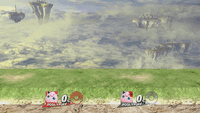
|
|---|
Taunts
- Up taunt: Happily spins in place on one foot, then looks and wiggles at the camera while inflated and smiling, all while saying "Jigglypuff!" (プリプリーン!).
- Side taunt: Twirls around then poses while looking away at the opposite side it is facing, then blinks twice. This taunt is very similar to Kirby's side taunt, although Jigglypuff does not vocalize at the end. Also similar to its official artwork.
- Down taunt: Deflates and falls to the ground, flattened, then quickly inflates again. While flattened, its hurtbox becomes significantly smaller. This taunt is similar to its fainting animation in home console Pokémon games, like Pokémon Battle Revolution.
| Up taunt | Side taunt | Down taunt |
|---|---|---|
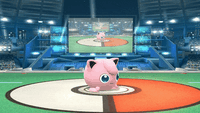
|
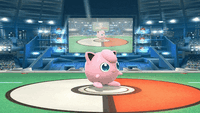
|
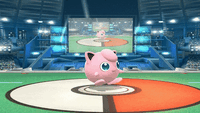
|
Idle Poses
- Looks at its side while jumping.
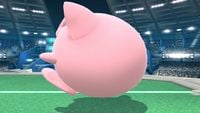
|
|---|
Crowd cheer
| English | Japanese | |
|---|---|---|
| Cheer | 0:02 | 0:02 |
| Description | Jigglypuff! | Pu-ri-n! |
| Pitch | Group chant | Female |
Victory poses
- Jumps twice, then does a backflip and looks toward the screen.
- Shivers while asleep and suddenly jumps up after awaking, rolling back and forth on its back.
- Uses Rest.
 |
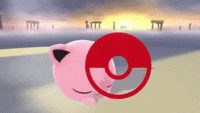 |
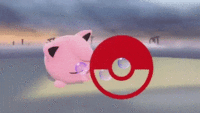
|
|---|
In competitive play
Official Custom Moveset Project
| Character | Custom sets available | ||||
|---|---|---|---|---|---|
| 1121 | 1122 | 1321 | 1322 | 2121 | |
| 2122 | 2321 | 2322 | 3121 | 1221 | |
Most historically significant players
Any number following the Smasher name indicates placement on the PGR 100, which recognizes the official top 100 players in Super Smash Bros. 4 of all time.
See also: Category:Jigglypuff professionals (SSB4)
Arika - One of the best Jigglypuff players in the world. Placed 17th at Umebura Smash 4 Final and 33rd at Umebura 32 with wins over players such as Masashi and Kome.
Captain L - Used Jigglypuff as a secondary alongside Pikachu, and is considered one of the best Jigglypuff players in the world. Place 5th at Saints Gaming Live 2018, 9th at CEO 2018, and 13th at Smash 'N' Splash 4 with wins over players such as Larry Lurr and BestNess.
Hungrybox - One of the best Jigglypuff players in the United States. Placed 5th at Full Bloom 3, 17th at FC Smash 15XR: Return, and 25th at WTFox 2 with a win over Fatality.
LeeT - Formerly played Jigglypuff and was previously considered the best Jigglypuff player in the world. Placed 33rd at Shine 2016 and 49th at CEO 2017.
MASTER PUFFY - The best Jigglypuff player in Mexico. Placed 13th at Smash Fest 3 and 17th at ConComics April 2018 with wins over players such as Richi, QROG, and Dano. Ranked 51st on the Mexican Power Rankings.
Tier placement and history
In the early metagame, it was widely considered that Jigglypuff was, at best, a mid-tier to low-tier character, and that Jigglypuff's buffs from Brawl would allow it to perform better in SSB4. However, its results and representation outside of doubles play were never as high as other characters that would rank above it in the future, and it would soon become clear that Jigglypuff had ironically lost much more than it gained in the transition. Despite the improved balancing of other characters, it infamously remained stagnant in game updates, with only a glitch that gave Rollout mindgame potential being fixed in update 1.0.4. As such, it was ranked 55th on the first 4BR tier list, making it the second lowest ranked character on the entire tier list.
Jigglypuff continued to languish near the bottom of the tier list, due to still being unchanged positively by game updates while other bottom-tier characters like Zelda and Ganondorf have received numerous buffs. Despite LeeT placing 33rd at Shine 2016 while exclusively using Jigglypuff for the tournament's entirety, it was nonetheless ranked 58th, placing it at the very bottom of the entire tier list. This has continued into the third tier list, with the only slight change to its tier status being its reassessment as a low-tier character due to the bottom-tier being abolished. Although some players felt that Jigglypuff has earned a slightly higher placement on the tier list due to having better results and representation than some characters ranked above it, Jigglypuff once again ranked dead last at 55th on the fourth and current tier list, even after the exclusion of Miis from the tier list.
It wouldn't be until 2018 that Jigglypuff would start seeing improvements in the metagame. Captain L started using Jigglypuff as a secondary alongside Pikachu and has gotten impressive placings such as 2nd at Arcane Tournaments 2018, 3rd at Flatiron 3, and 25th at GENESIS 5. Captain L used Jigglypuff to defeat players such as John Numbers, Larry Lurr, BestNess, Strike, Blank, and Pandarian, and has also taken ESAM to game 5. Furthermore, Arika would make an impressive run at Umebura Smash 4 Final where he would defeat Masashi and takera en route to a 17th place finish, the highest placement for a solo Jigglypuff player at a national tournament. Although these results took advantage of the opponent's lack of matchup experience, they nevertheless were more impressive than the results of several other low and mid characters such as Ganondorf, Dr. Mario, Kirby, Robin, Pit, Yoshi, and Dark Pit. Due to this, its position has become a point of debate; some smashers like Dabuz, Raito, and ESAM believe that Jigglypuff should be ranked higher while others claim that its weaknesses are too significant for it to be ranked any higher. Regardless, Jigglypuff is still considered to be one of the worst characters in the game and is considered nonviable throughout the game’s entire competitive lifespan.
Trophies
- Jigglypuff
This Normal- and Fairy-type Pokémon is best known for its soothing singing, which quite often puts foes to sleep. In this game, Jigglypuff fights best in the air, and can even jump six times in a row. The downside, though, is that Jigglypuff's so light, just about any opponent could launch it in their sleep!
- Jigglypuff (Alt.)
When you use the Rest down special, you go into a deep sleep, as you'd expect. But if anyone is touching you when you do it, you'll inflict a lot of damage and launch them directly upwards. They even continue to take damage afterwards. It's not easy to pull off, though, and falling asleep leaves you open to attacks, so be careful.
- Puff Up
When Jigglypuff uses its Final Smash, it starts to grow bigger. And bigger. And bigger! Before you know it, Jigglypuff will have completely taken over the screen-and there's no way to make it stop. On smaller stages, fighters may find there's nowhere left to stand! At near full size, Jigglypuff will damage and launch anyone it touches.
It doesn't deal a lot of damage or launch opponents a long way. No, when Jigglypuff uses its Final Smash, it gets...bigger. And bigger. And bigger. Before you know it, Jigglypuff will have completely taken over the screen - and there's no way to make it stop. On smaller stages, fighters may find there's nowhere left to stand!
In Event Matches
Solo Events
- All-Star Battle: Secret: Jigglypuff is one of the opponents fought in this event. All opponents are characters that have been unlockable in previous Super Smash Bros. games.
- It's Past Your Bedtime!: Jigglypuff must use Sing to make Ness, Bowser Jr., and Toon Link fall asleep at the same time.
Co-op Events
- The Ultimate Battle: Two players select a character and must defeat the entire roster.
Alternate costumes

| |||||||

|

|

|

|

|

|

|

|
Gallery
Jigglypuff's amiibo.
Preparing to throw Captain Falcon.
Using Puff Up.
With R.O.B., Ness, and Pikachu.
Taunting while being spotted by 5-Volt on Gamer.
Trivia
- Super Smash Bros. for Wii U is the only installment where Jigglypuff is a starter character. As a result, Jigglypuff had appeared in various official screenshots and videos (such as the October 2014 Wii U Direct) without acknowledgement before its official reveal.
- Jigglypuff was the last character overall to be fully confirmed on the SSB4 website before the initial release of Super Smash Bros. for Wii U and, by extension, the last of the "perfect-attendance crew" to be announced.
- Jigglypuff's official artwork pose is a mirrored version of its pose from its official artwork from Pokémon Red and Green Versions. SSB4 is also the first Super Smash Bros. game to not have Jigglypuff fully face the screen in its official art and is the first game to give Jigglypuff a new character artwork.
- While Jigglypuff's textures are completely unique in Super Smash Bros. for Nintendo 3DS, its actual 3D model is very similar to its model used in Pokémon X and Y.[2]
- While most fighter trophies are sorted by debut appearance and then by unlockability within the type sorting, Jigglypuff is different in that it is placed between the Brawl characters and the SSB4 characters in the list.
- If done with correct timing, Jigglypuff can avoid damage by using its down taunt, even though many attacks can still hit it. Also, if its down taunt is used next to a cannon in the stage builder, Jigglypuff will be launched by said cannon.
- Jigglypuff is the only starter character in Super Smash Bros. for Wii U who has a challenge exclusive to it that cannot be unlocked with a Golden Hammer.
- Jigglypuff is also the only non-DLC character in SSB4 to have only one blast line KO voice clip.
- Ness and Jigglypuff are the only members of the "perfect-attendance crew" to not appear in any of the newcomers' poster art.
- Jigglypuff's grab uses part of Rollout's sound normally, In fact, if one uses 1/2x or 1/4x speed in SSB4 and uses Jigglypuff's grab, the Rollout sound effect will play until Jigglypuff finishes its grab. If the Hold L speeds are used, this will continue until time is unpaused.
- This is the last Smash game where Jigglypuff's icon shows its whole body instead of just its face.
- Jigglypuff, Ganondorf and Zelda are the only three characters to be the lowest tiered characters in 2 games in a row.
References
| show Fighters in Super Smash Bros. 4 |
|---|
| show
|
|---|
